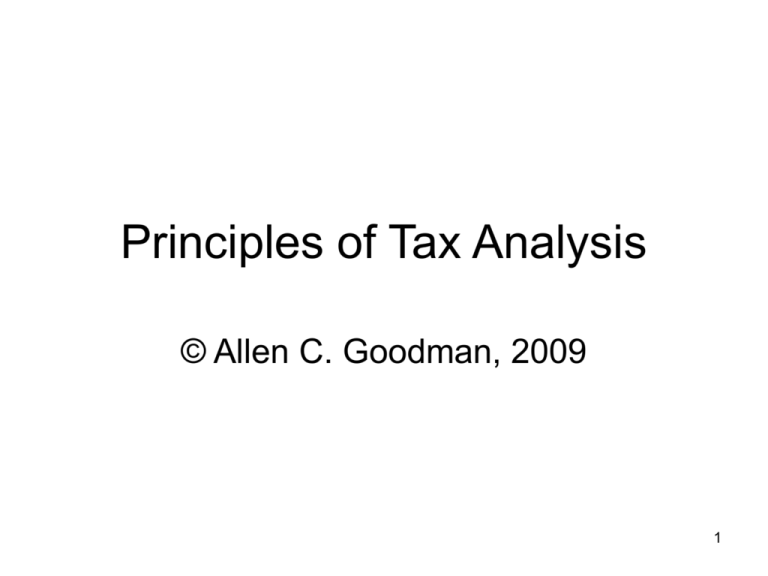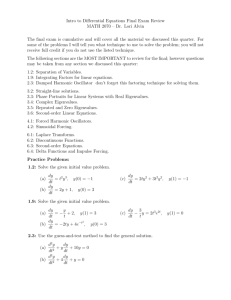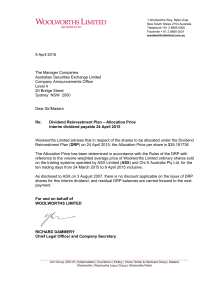Principles of Tax Analysis
advertisement

Principles of Tax Analysis © Allen C. Goodman, 2009 1 Lots of Different Taxes Income/Business Personal Income Corporate Income Value-Added License Consumption Sales Use Motor Fuel Alcoholic Beverage Hotel/Motel Restaurant Meals Most economists Telephone Call Don’t like this one. Gambling Wealth Property Estate Inheritance Transfer Why? 2 Lots of Different Taxes Income/Business Consumption Wealth Personal Inc. Corporate Inc. Value-Added License Sales Use Motor Fuel Alcoholic Beverage Hotel/Motel Restaurant Meals Telephone Call Gambling Property Estate Inheritance Transfer 3 Lots of Different Taxes Income/Business Consumption Wealth Personal Inc. Corporate Inc. Value-Added License Sales Use Motor Fuel Alcoholic Beverage Hotel/Motel Restaurant Meals Telephone Call Gambling Property Estate Inheritance Transfer Why good? Why bad? 4 Tax Incidence • Who REALLY pays the tax • If you buy something at the store, you give $ to the clerk, and the store pays $ to the gov’t, but who really pays? • If you rent an apartment and property taxes in your city rise, what happens to the rent that you pay? Who really pays? 5 Tax Incidence and Burden • Progressive Tax – Tax Burden/income ↑ as income ↑ • Proportional Tax – Tax Burden/income is constant as income ↑ Tax • Regressive Tax – Tax Burden/income ↓ as income ↑ Income 6 Ave Ray to origin Mgl slope Progressive Tax Average Marginal ΔT T • Progressive Tax – Tax Burden/income ↑ as income ↑ – Slope of ray = T/Y – Mgl Tax Rate = ΔT/ΔY • Example – Gas Guzzler Tax • Federal Income Tax ΔY Y Tax Mgl. Tax Rate Ave. Tax Rate T Y1 Y2 Y3 Income 7 Ave Ray to origin Proportional Tax Mgl slope Average Marginal ΔT T • Proportional Tax – Tax Burden/income constant as income ↑ – Slope of ray = T/Y – Mgl Tax Rate = ΔT/ΔY Y ΔY Tax • Example – Medicare Tax Y1 Y2 Y3 Income 8 Ave Ray to origin Mgl slope Regressive Tax Average Marginal ΔT T • Regressive Tax – Tax Burden/income ↓ as income ↑ – Slope of ray = T/Y – Mgl Tax Rate = ΔT/ΔY ΔY Y Tax Mgl. Tax Rate • Example – FICA tax for Social Security Y1 Y2 Y3 Income 9 FICA and Medicare FICA and Medicare Taxes 7000 FICA Tax - 2008 6000 FICA Tax - 2009 Taxes ($) 5000 Medicare Tax 4000 3000 2000 1000 0 0 20000 40000 60000 80000 100000 120000 Payroll Income 10 General Rules for Taxes • Only way (legally) to avoid taxes is to change behavior. • The more that one agent can avoid the tax – the less is collected – the more someone else pays 11 Efficient Quantity! WHY? Taxes and Efficiency • Excise Tax – Tax on a particular good. – Look at a unit (as oppose to percentage) tax. D S $ P0 • Partial eq’m analysis looks at a single market. Q0 12 Q Taxes and Efficiency • Excise Tax – Tax on a particular good. – Look at a unit (as oppose to percentage) tax. • $1 Tax Collected on DEMANDERS D S $ Why is this treated as a downward shift? P0 3.0 Suppose you buy gasoline at $3.00 per gallon. $1 Your state imposes a $1.00/gallon tax. You keep your receipts and pay tax. You demand based on $2.00 per gallon, because you know you’ll have to pay an additional $1.00. Your demand curve shifts DOWN by $1.00. Q0 13 Q Taxes and Efficiency • Excise Tax – Tax on a particular good. – Look at a unit (as oppose to percentage) tax. D S $ D' P1 P0 3.0 Total Revenue $1 • $1 Tax Collected on DEMANDERS Who Pays? Q1 Q0 14 Q Taxes and Efficiency • Excise Tax – Tax on a particular good. – Look at a unit (as oppose to percentage) tax. D S $ P1 Con. P0 3.0 DW Prod. $1 • $1 Tax Collected on DEMANDERS What’s DW$ Q1 Q0 15 Q EXACTLY the same result. Suppose the $1 is on Suppliers? • Excise Tax – Tax on a particular good. – Look at a unit (as oppose to percentage) tax. D S $ P1 P0 3.0 Cons. Total RevenueDW Prod. • $1 Tax Collected on SUPPLIERS Who Pays? Q1 Q0 16 Q If result is same … • Why do we usually collect sales taxes from the sellers? • Do we ever try to collect it from the buyers? • What happens when we do? 17 Important Concepts! • DW loss relates to the change in quantity. Remember, we saw that efficiency related to quantity. The more behavioral change that a tax makes, the more DW loss. • Incidence relates to elasticity of demand and supply. Remember elasticity addresses whether quantity changes a little or lot. If you can change your behavior a lot, and avoid the tax, its incidence on you is small. • If you can’t change your behavior and avoid it, its incidence is a lot! Does it matter how we collect the tax? 18 Another Gas Tax Example S' • Suppose that Southfield puts a $1/gallon tax on gas. • Let’s look at demand and supply. • Why did I draw demand and supply like I did. Who Pays? Price ↑ a little; Quantity ↓ a lot Most is paid by producers. S $ $1 P1 Consumer P0 Total (yellow) D by producer Q1 Q0 19 Quantity Another Gas Tax Example S' • Suppose that the US puts a $1/gallon tax on gas. • Let’s look at demand and supply. • Why did I draw demand and supply like I did. Who Pays? S $ P1 $1 Tax Collected P0 D Price ↑ a lot; Quantity ↓ a little Most is paid by consumers. WHY? Q1 Q0 20 Quantity Excess Burden – Gen’l Eq’m Other Goods • Previously, we looked only at a single market. Even if a tax doesn’t change quantity in a given market it may change behavior in other markets. • We can’t measure U1 – U2, but we CAN, in principle, measure the cost in $ of this excess burden. U1 U2 U0 Excess Burden 21 Gasoline Even if Q doesn’t change! – Gen’l Eq’m Other Goods • Previously, we looked only at a single market. Even if a tax doesn’t change quantity in a given market (again, suppose it’s gasoline) it may change behavior in other markets. • Again we can’t measure U1 – U2, but we CAN, in principle, measure the cost in $ of this excess burden, even though the amount of gas did not change. U0 U1 U2 22 Gasoline WHO REALLY PAYS? Tax Incidence © Allen C. Goodman, 2009 23 What has been happening • Over time, the share of output generated from the relatively less cyclically sensitive service-producing industries has risen modestly in comparison with relatively larger cyclically sensitive goods-producing industries. • So, as the share of services has risen the share (and possibly the amount) of goodsbased sales taxes has fallen. 24 Sources of State Revenues • Go to Spreadsheet All States http://www.census.gov/compendia/statab/cats/state_local_govt_finances_employment/state_government_finances.html25 Where does Michigan stand? • Go to Spreadsheet. http://www.census.gov/compendia/statab/cats/state_local_govt_finances_employment/state_government_finances.html26 Why drawn like this? Short-Run and Long-Run Impacts D $ • Look at SR supply elasticities? • Look at SR demand elasticities? • What is impact of 6% tax on services? S' S P2 P1 Total Tax Rev. DW is small Total Sales Q2 Q1 Quantity 27 Supply more elastic Long-Run Impacts D $ • Look at LR supply elasticities? • Look at LR demand elasticities? • What is impact of 6% tax on services? S'' S' S D'' Demand more elastic P2 P1 Tot. Tax Rev. Tot Sales Q2 Q1 Quantity 28 Long-Run Impacts D $ • What is net impact as drawn? • P3 < P2 because demand is more P3 elastic • TR? Depends on whether price ↑ (leading to ↑ in tax per unit) by greater % than quantity ↓. S'' S' S D'' P2 P1 Tot. Tax Tax Rev. Rev. New Tot Sales Q3 Q2 Q1 Quantity 29 A Model of a Michigan Service Tax 1 = goods produced nationally– examples? 2 = goods produced locally – examples? T = Taxes Collected by Michigan T = National sector taxes + Local Sector taxes + - T = t1 p1 Q1 (t1, t2, p1, p2, y) + t2 p2 Q2 (t1, t2, + - + p1, p2, y) What happens if we y = p1 Q1 + p2 Q2 establish (increase) taxes on local goods, services? 30 What will the Full Impact of a tax on local goods be? • Lots of things happen!! • Prices of local goods , in quantity demanded of local goods. • in demand for national goods. • What will be the TAX IMPACT and who will pay it? 31 What will the Full Impact of a tax on local goods be? dT/dt2 = p2 Q2 + t2 p2 (dQ2/dt2) + t2 p2 (dQ2/dp2 ) (dp2/dt2 ) + t1 p1 (dQ1/dt2 ) Less Sold! But it Is now taxed. Higher prices, Less sold. More taxes on Substitutes. 32 What will the Full Impact of a tax on local goods be? dT/dt2 = p2 Q2 + t2 p2 (dQ2/dt2) + t2 p2 (dQ2/dp2 ) (dp2/dt2 ) + t1 p1 (dQ1/dt2 ) dT/dt2 = p2 Q2 + t2 (dQ2/dt2 ) (Q2/Q2) p2 + (Q2/Q2)(p2/p2) t2 p2 (dQ2/dp2 ) (dp2/dt2 ) + (t2/t2) (Q1/Q1) t1 p1 (dQ1/dt2) dT/dt2 = p2 Q2 + dQ2/dt2 (t2 /Q2) (p2 Q2) + p2 Q2 [(dQ2/dp2) (p2/Q2)] [(dp2/dt2) (t2/p2)] + (t1/t2)(p1Q1) (dQ1/dt2) (t2/Q1) dT/dt2 = p2 Q2 + Elas Q2t2 (p2 Q2) + p2 Q2 (Elas Q2p2) (Elas p2t2) + (t1/t2)(p1Q1) (Elas Q1t2) dT/dt2 = p2 Q2 (1 + Elas Q2t2 + Elas Q2p2 Elas p2t2)+ p1Q1 (t1/t2) (Elas Q1t2) 33 A Model of the Service Tax + or - ? + or - ? + or - ? dT/dt2 = p2 Q2 (1 + Elas Q2t2 + Elas Q2p2 Elas p2t2)+ p1Q1 (t1/t2) (Elas Q1t2) + or - ? KEY POINT --- There are LOTS of Impacts! 34 t2 = 0.06 A 6% Service Tax This is a one UNIT in tax. We want 0.06 of that. dT/dt2 = p2 Q2 (1 + Elas Q2t2 + Elas Q2p2 Elas p2t2)+ p1Q1 (t1/t2) (Elas Q1t2) 0.06* (dT/dt2) = 0.06 * p2 Q2 (1 + Elas Q2t2 + Elas Q2p2 Elas p2t2)+ 0.06 * t1p1Q1 (Elas Q1t2) Elas Tt2 = s2 (1 + Elas Q2t2 + Elas Q2p2 Elas p2t2) + s1 * Elas Q1t2 ; s1 = t1p1Q1/T; s2 = t2p2Q2/T. 35 t2 = 0.06 A 6% Service Tax dT/dt2 = p2 Q2 (1 + Elas Q2t2 + Elas Q2p2 Elas p2t2)+ p1Q1 (t1/t2) (Elas Q1t2) 6% of original sales of Q2 0.06* (dT/dt2) = 0.06 * p2 Q2 (1 + Elas Q2t2 + Elas Q2p2 Elas p2t2)+ 0.06 * p1Q1 (t1) (Elas Q1t2) Change in sales of Q1 Elas Tt2 = s2 (1 + Elas Q2t2 + Elas Q2p2 Elas p2t2) + s1 * Elas Q1t2 ; s1 = t1p1Q1/T; s2 = t2p2Q2/T. 36







